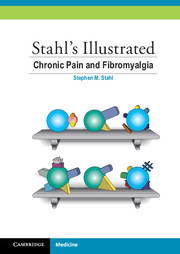Chapter 5 - Pain Drugs
Published online by Cambridge University Press: 19 October 2021
Summary
Chapter 5 compares the mechanism of opiates to the mechanisms of non-opiate drugs that are also effective in treating many types of pain disorders. Whereas opiates are effective for decreasing acute pain, they also affect many other areas of the brain in ways that may not be optimal for many patients with chronic pain. Chapter 5 introduces drugs that can be highly effective in treating pain disorders, along with some tips and pearls on dosing and prescribing.
In most cases, a single drug is unlikely to relieve all pain. Therefore, combinations of drugs based on complementary mechanisms of action will ultimately alleviate the greatest amount of pain. The drugs presented in this chapter may not work well for people who have been on opiates for some time or who continue to take opiates, as opiates can decrease the effectiveness of other drugs. The ideas presented in this chapter are intended to encourage prescribers to treat patients early and in ways that may prevent or reduce the need for chronic opiate treatment, so as to encourage the greatest level of remission and achieve the highest quality of life.
Lidocaine is effective for acute nociceptive pain, and is also approved for the treatment of postherpetic neuropathic pain. It is available in a variety of formulations, most commonly as a patch or gel.
Anti-inflammatory agents such as cyclooxygenase (COX)- 2 inhibitors can be effective in a wide variety of pain states associated with inflammation, including presumably several types of neuropathic pain (see Figures 2.14 and 2.15). Cyclooxygenase- inhibiting nitric oxide donating drugs (CINODs) may also be effective for pain, with decreased gastrointestinal damage, providing a potential benefit for patients that require long-term anti-inflammatory treatment.
Because of their purported progressive nature, pain disorders that are caught early enough can be largely treated with NSAIDs, COX-2 inhibitors, or CINODs.
Particularly in the treatment of osteoarthritic pain and chronic lower back pain, TCAs have been a treatment of choice. However, their wide-ranging side effects and low tolerability profile have led researchers and clinicians to seek other options. While TCAs remain commonly prescribed for chronic painful disorders, other treatments may prove to be more holistically effective.
- Type
- Chapter
- Information
- Stahl's Illustrated Chronic Pain and Fibromyalgia , pp. 81 - 122Publisher: Cambridge University PressPrint publication year: 2009

